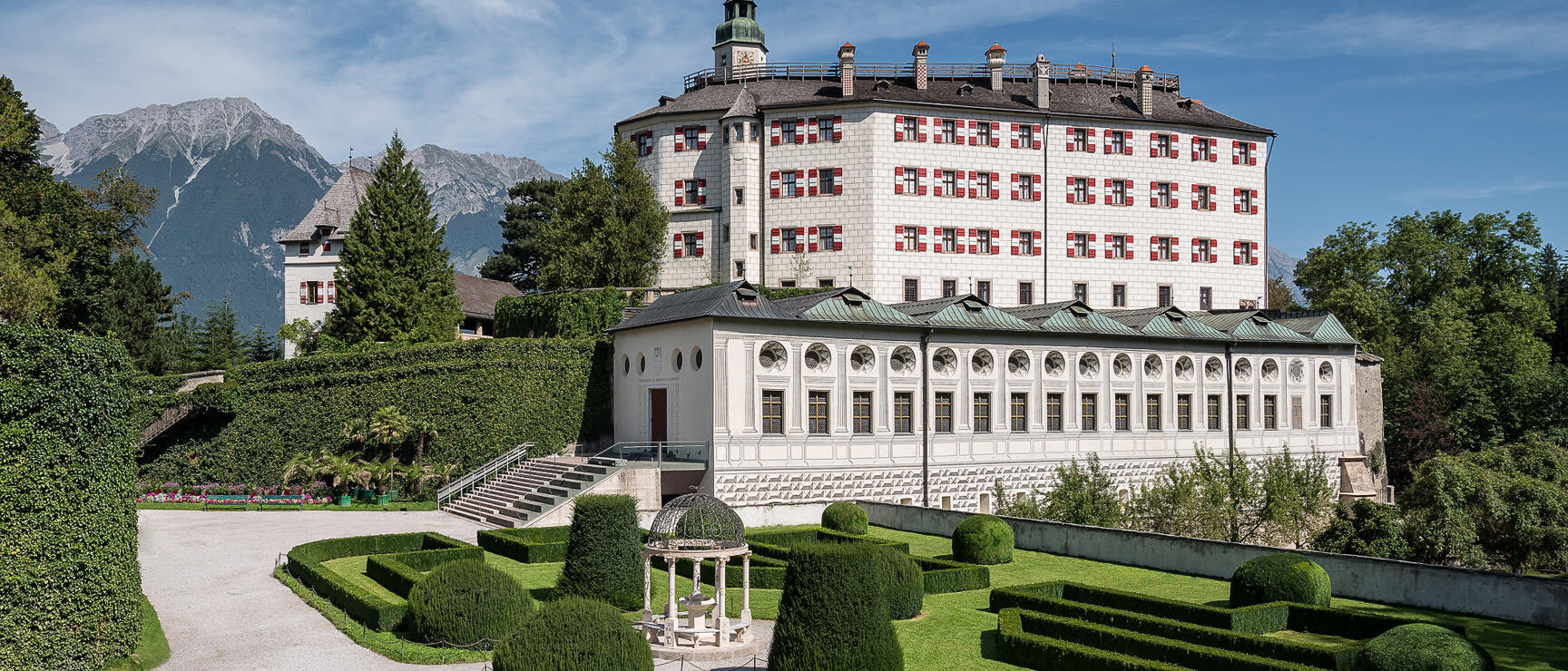
Ambras Castle
The first museum in the world
Ambras Castle: A fairytale castle
Perched on a hill above Innsbruck and surrounded by a sprawling park, Schloss Ambras looks like something out of a fairytale. This Renaissance castle enchants visitors with its rich history and unique blend of art, culture, and charm.
A significant seat of power during the Middle Ages, Schloss Ambras gained its distinctive brilliance under Archduke Ferdinand II. Beginning in 1564, he transformed the medieval fortress into a magnificent residence. He commissioned the Unterschloss (Lower Castle) to house the renowned Ambras Collections—a groundbreaking achievement, celebrated as the world’s first museum.
A journey through time
During Ferdinand’s time, the living quarters were in the Hochschloss (Upper Castle). Today, it hosts the Habsburg Portrait Gallery, featuring masterpieces by Velázquez, van Dyck, and Rubens. Visitors can also explore the Kunst- und Wunderkammer (Chamber of Art and Curiosities) and the Armoury, bringing the Renaissance to life. The Spanish Hall, one of Europe’s most stunning festival halls, becomes a magical stage for summer concerts. Outside, the castle gardens—with their ancient trees, hidden corners, Paradise Garden, and Apothecary Garden—invite moments of relaxation.
Philippine Welser: A woman who inspires
Philippine Welser, Ferdinand’s secret wife, was much more than the “lady of the castle.” She was passionate about medicinal plants, herb gardens, and culinary arts. Her famous Cookbook of Philippine Welser, the oldest known culinary manuscript by a woman in the German-speaking world, and the preserved “Philippine Baths” stand as enduring testaments to her wisdom in health and wellbeing. Known for her compassion, she devoted herself to helping others—a spirit that still resonates throughout Schloss Ambras.
Whether in its historic halls or under open skies, Schloss Ambras is a place where stories come to life. Here, tradition meets innovation, and history blends seamlessly with modernity—giving every visit a touch of magic.
Music lovers can enjoy the original sounds of instruments that were often still made using traditional methods at the Festival of Early Music in the impressive setting of the Spanish Hall.
Meet Ambras Castle
The palace and its treasures
A gift of love
Archduke Ferdinand II and his Philippine Welser
As the second son of the Emperor, Archduke Ferdinand II was expected to marry someone of noble rank. However, in 1557, he secretly wed his great love, Philippine Welser, a beautiful merchant’s daughter from Augsburg. While such a union was permitted by the Church, it was socially unacceptable at the time.
Philippine lived in seclusion at Schloss Ambras, which had been given to her. The couple enjoyed a happy marriage and had four children, though they were excluded from the Habsburg line of succession. It was only after their eldest son Andreas was appointed a cardinal that the Pope absolved the pair from keeping their marriage secret.
Philippine devoted herself to caring for the sick, using her extensive knowledge of medicinal herbs to help those in need. She is also said to have perfected traditional home-style cooking and even co-authored a cookbook.
Wellness in the 16th century
Philippine Welser's bath
The opulent bathing wing of Schloss Ambras was far more than a private retreat. Bathing was a social ritual: guests were served food and drinks as they soaked, often spending several hours in the process. It also provided a rare opportunity to glimpse naked bodies—a daring indulgence in the prudish society of the time.
Philippine Welser’s bathing wing was exceptionally luxurious for its era, and bathing was an integral part of the duchess’s daily routine. The 1.6-metre-deep pool could be heated using either an oven or hot stones. Philippine’s passion for medicinal herbs found its way into her baths, as she added them to the water for their healing properties.
Legend has it that Philippine met her end in this very bathtub. A persistent myth suggests that her mother-in-law, who never accepted her son’s marriage to a commoner, played a role in Philippine’s untimely death, hinting it may not have been a natural one.
The gardens and art at Ambras Castle
FAQs
Climate Protection Information
Social and ecological sustainability
Monument protection ensures the long-term preservation and continued use of historic buildings. By maintaining and restoring structures like castles, palaces, and monuments, valuable resources such as building materials are conserved, and soil sealing from new constructions is avoided.
This preservation not only contributes to climate protection by reducing environmental impact but also safeguards traditional craftsmanship. Restoring historical buildings often relies on age-old materials and techniques, keeping ancient knowledge and skills alive.
Additionally, improving accessibility and inclusion in art and cultural experiences promotes social sustainability, fostering respectful coexistence and strengthening community bonds.